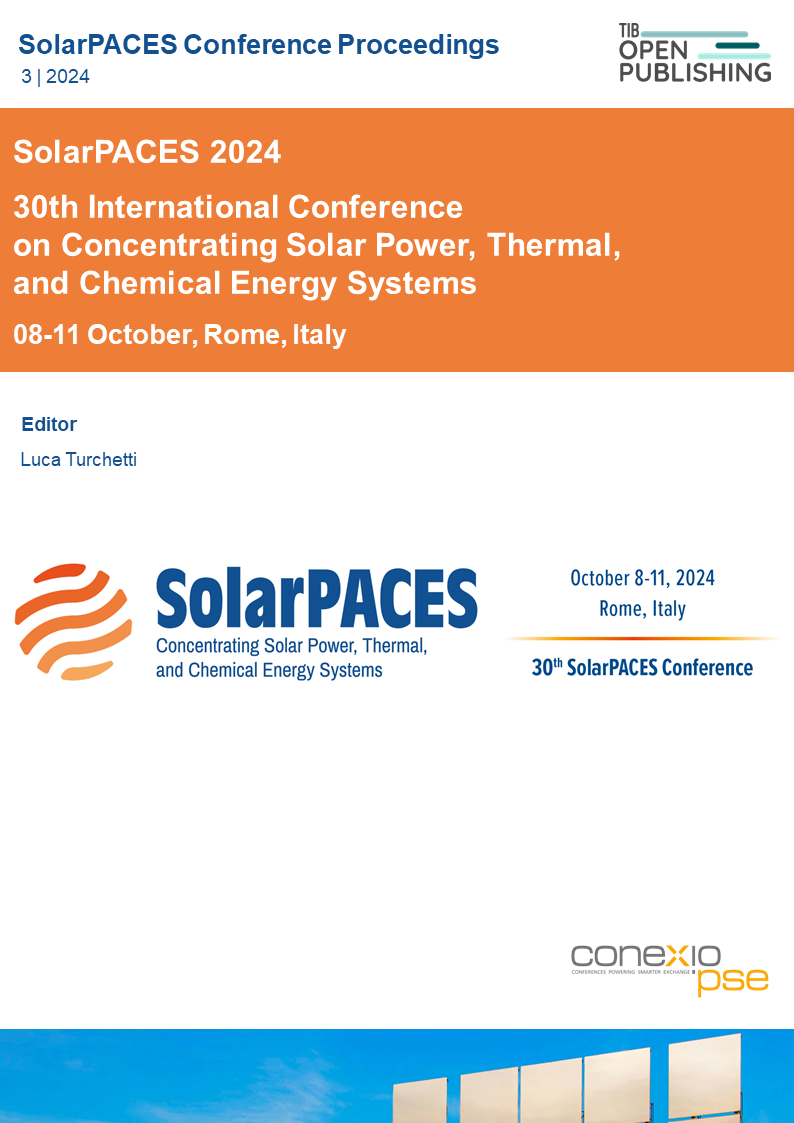A Comparative Analysis Between Ceramic and Metallic Receiver Designs
DOI:
https://doi.org/10.52825/solarpaces.v3i.2442Keywords:
Solar Receiver, High Temperature Design, ReliabilityAbstract
The outlet temperature targets for Gen 3 Concentrating Solar Power (CSP) systems pose a significant challenge to the structural reliability of high-temperature metallic materials. Advanced ceramics are a promising option due to their high temperature strength and low thermal expansion. However, challenges such as limited ductility and fabrication issues need to be addressed. Before tackling manufacturing challenges, CSP developers must determine the viability of high temperature ceramic components in system design, considering factors like plant operating life. This paper presents a comparative design analysis of tubular external receivers constructed from a high temperature nickel-based superalloy, A740H and a monolithic ceramic material, commercial SiC, using srlife, an open-source receiver evaluation and life prediction tool. Results indicate that A740H receivers can achieve a 30-year service life if the flux is limited to 450 kW/m², which may not be economically viable. In contrast, the Weibull 3-parameter model estimates a service life exceeding 30 years for SiC receivers, even at a much higher flux limit of 1000 kW/m².
Downloads
References
M. Mehos, et al. “Concentrating solar power Gen3 demonstration roadmap.” National Re-newable Energy Laboratory technical report NREL/TP-5500-67464, 2017.
B. Barua, and M. C. Messner. “Structural design challenges and implications for high temperature concentrating solar power receivers.” Solar Energy 251 (2023): 119-133.
B. Barua, et al. “Design Guidance for High Temperature Concentrating Solar Power Components.” Argonne National Laboratory technical report ANL-20/03, 2020.
Barua, Bipul, Mark C. Messner, and Dileep Singh. "Assessment of Ti3SiC2 MAX phase as a structural material for high temperature receivers." AIP Conference Proceedings. Vol. 2445. No. 1. AIP Publishing, 2022.
Chaugule, Pawan S., et al. "Reliability comparisons between additively manufactured and conventional SiC–Si ceramic composites." Journal of the American Ceramic Socie-ty 107.5 (2024): 3117-3133.
M. C. Messner et al. “Towards a Design Framework for Non-metallic Concentrating Solar Power Components.” In the Proceedings of the 2021 SolarPACES Conference, 2021.
M.C. Messner, and B. Barua. "A fast tool for receiver life estimation and design." AIP Conference Proceedings. Vol. 2445. No. 1. AIP Publishing, 2022.
M.C. Messner, et al., “srlife: A Fast Tool for High Temperature Receiver Design and Analysis,” (No. ANL-22/29). Argonne National Lab.(ANL), Argonne, IL, 2022. (https://doi.org/10.2172/1871331)
Barua, Bipul, and Mark C. Messner. "Fast heuristics for receiver life estimation and de-sign." AIP Conference Proceedings. Vol. 2815. No. 1. AIP Publishing, 2023.
Messner, Mark, et al. "A Computer Design Tool for Ceramic Receivers." SolarPACES Conference Proceedings. Vol. 1. 2022.
Chaugule, Pawan, et al. "Investigating Various Failure Models on Commercial Silicon Carbide." SolarPACES Conference Proceedings. Vol. 1. 2022.
B. Barua, P. Chaugule, M.C. Messner, and D. Singh. “Time-dependent Failure Assess-ment of Ceramic Receivers.” SolarPACES conference, 2023 (under review).
P. Chaugule, et al., “Design Methods, Tools, and Data for Ceramic Solar Receivers,” , 2024 (upcoming report).
Wagner, Michael J., and Tim Wendelin. "SolarPILOT: A power tower solar field layout and characterization tool." Solar Energy 171 (2018): 185-196.
Published
How to Cite
Conference Proceedings Volume
Section
License
Copyright (c) 2025 Bipul Barua, Pawan Chaugule, Mark C. Messner, Dileep Singh

This work is licensed under a Creative Commons Attribution 4.0 International License.
Accepted 2025-04-11
Published 2025-11-19
